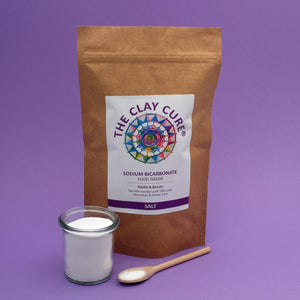With its natural pH neutralizing effects, sodium bicarbonate serves a variety of purposes.
Our Sodium Bicarbonate is:
- Best Quality Food Grade
- 100% Pure & Additive Free
- Vegan
- Aluminium free
What Is sodium bicarbonate?
Sodium bicarbonate (IUPAC name: sodium hydrogen carbonate) is a chemical compound with the formula NaHCO3. It is a salt composed of sodium ions and bicarbonate ions. Sodium bicarbonate is a white solid that is crystalline but often appears as a fine powder. It has a slightly salty, alkaline taste resembling that of washing soda (sodium carbonate). The natural mineral form is nahcolite. It is a component of the mineral natron and is found dissolved in many mineral springs. It is among the European Union-encoded food additives, identified as E 500.
A variety of health aids, personal hygiene products and household cleaners on the market today are laced with toxic cleaners and other concerning substances. Sodium bicarbonate, on the other hand, is a natural chemical compound. From its use as a medicinal substitute to a household cleaning product, sodium bicarbonate is effective at restoring balance in the body and the home without harsh chemicals or toxins.
Sodium bicarbonate, is a natural substance that helps regulate pH. This regulation keeps a substance from becoming too acidic or too alkaline, which is important in maintaining health.
Guaranteed 100 % pure, our clays are a natural source of the following major trace elements: Magnesium(Mg), Calcium(Ca), Potassium(K), Manganese(Mn), Zinc(Zn), Phosphorus(P), Iron(Fe), Aluminum(Al), Silicon(Si), Copper(Cu), Selenium(Se), Cobalt(Co), Molybdenum(Mo) as well as lots of other elements.
Clay has been used for thousands of years, and yet, no one can pin down fully what makes it a healer.
Some are only happy to use it in every case they judge appropriate, and achieve great results. This is why we are full of wonder every time clay accomplishes a cure we did not expect, in so little time.
Most users of clay leave scientific explanations aside when they come astounded by the accomplishments of clay.
Clay is effective as a DYNAMIC PRESENCE far more significantly than a mere consideration of the substances it contains.
It is a catalyst rather than an agent itself.
This is possible because clay is ALIVE.
Clay is a live medium which helps generate and maintain life.
Our range of clays do not come from someone's backyard! Every extraction is analyzed and inspected and meets all microbiological standards. Our clay will always be at its purest and highest quality.
The use of clay is endless!
Many of the minerals needed by the body are, essentially, dirt or rock. Though we most often consume them taken up in plant or animal form, nearly all mammalian species engage in some form of direct earth eating to prevent nutritional deficiency. An obvious example is the dietary use of salt among humans, and the frequenting of salt licks by mammals such as deer, cattle and sheep to obtain minerals such as sodium, calcium, iron, phosphorous and zinc.
Given this fact, the relationship between mineral deficiency and clay and soil eating was among the first to be examined. Scientists have hypothesized earth-eating as an adaptive behavior based on nutritional requirements, one that occurred and persisted on an evolutionary basis due to its survival benefits.
Though the study of clay consumption has revealed the potential for digestive and nutritional benefits, scientists believe the most conclusive evidence points to detoxification as a primary benefit of clay eating throughout human history. Its use appears to be one borrowed from and shared by numerous animal species, attesting to its practice not as an anomaly or aberrant behavior but instead a true adaptive practice contributing to survival and evolution.
One example from the animal kingdom is the use of clay by animal species that regularly scavenge for a wide variety of foods, often of varying toxicity. Researchers discovered that the ingestion of clay by such species, among them birds, parrots, rats and primates, enables a diverse diet without suffering the toxic effects of substances consumed. The chemical structure of earthen clay determines their suitability as a detoxicant.
Eating clay, far from an eating disorder, may instead be history's earliest example of using the earth's resources to solve medical problems. With recent evidence revealing clay's common use in lowering food toxicity and promoting digestive health and detox, this ancient practice may continue to have much to teach us about medicine and healing.
Disclaimer: Please be advised that according to the EU regulations, clay and clay-like substances are not regarded by the EU authorities as food products, and we are not selling or marketing them as such, but simply as generic products. We provide general information about clays and minerals which we have collected online and from various publications. Clays or minerals are not being sold by us as medicines or food supplements. We do not provide diagnosis or advice. If you have any medical problem, please consult your medical practitioner.




